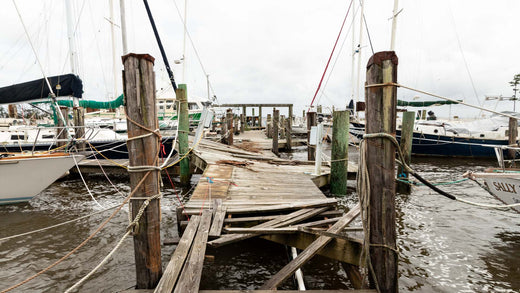
How to Prepare Your Boat for a Hurricane
Nicholas HeislerShare
With the recent impact of hurricanes Helene and Milton, it's clear that storm season can be devastating for boat owners. As severe weather patterns continue to disrupt coastal communities, it's more important than ever to ensure that your boat is properly secured and protected. This blog offers guidance on how to prepare your vessel for a hurricane, whether it's docked, moored, or stored on land. By taking the right steps now, you can minimize damage and safeguard your investment against the forces of nature. Let's explore how to protect your boat and navigate this challenging season with confidence.
1. Create a Hurricane Preparedness Plan
Before hurricane season even starts, have a detailed plan in place. This plan should include the following:
- Evacuation Route and Timeline: Determine when and how you'll secure your boat depending on the hurricane's category and path.
- Boat Location: Decide if your boat will stay at the marina, be moved to a more secure location, or hauled out of the water and stored on land.
- Contacts and Communication: Make sure you have contact information for your marina, insurance company, emergency services, and anyone who might help you prepare your boat.
2. Inspect and Maintain Your Boat
Regular inspections and maintenance are essential to ensure your boat is in top condition when a storm approaches. Specifically:
- Check Bilge Pumps: Ensure your bilge pumps are working properly and that the battery is fully charged to handle excess water.
- Inspect Cleats, Lines, and Chocks: Make sure all fittings are secure and capable of handling heavy loads.
- Secure Electronics and Loose Items: Remove any valuable electronics and secure or stow away loose items like life vests, cushions, and any deck gear.
3. Secure Your Boat in a Marina (Storage option 1)
If your boat is staying in a marina, secure it with strong mooring lines and fenders. Here are a few key steps:
- Double Up on Dock Lines: Use extra lines to secure your boat, and ensure that these lines are long enough to handle changing water levels.
- Use Chafing Gear: Protect your lines from wear by using chafing gear where they rub against cleats, pilings, or the deck.
- Install Fenders: Place fenders on both sides of the boat to protect it from impact with the dock or other boats, preventing damage and dock rash.
4. Mooring and Anchoring Your Boat (Storage option 2)
For boats that are moored or anchored, you'll need to take additional precautions:
- Use Multiple Anchors: Position two or three anchors in a Y or triangle configuration to keep your boat from swinging.
- Increase Scope: Let out additional anchor line to create a larger scope (ratio of anchor line length to water depth), which provides more holding power.
- Moor Away from Obstructions: Choose a mooring area that is clear of other boats and large objects that could cause damage if your boat breaks loose.
5. Hauling Out and Storing Your Boat on Land (Storage option 3 - Recommended)
Hauling your boat out of the water can be one of the safest ways to protect it during a hurricane. If you have this option:
- Store on a Trailer: Make sure the trailer is secured and that the boat is tied down. Place blocks or remove tires to prevent the trailer from moving.
- Stabilize the Boat: Use jack stands to stabilize the hull and reduce the risk of tipping over.
- Consider Shrink Wrapping: If your boat will remain outside, consider shrink-wrapping it to prevent water intrusion and wind damage.
6. Remove and Secure Equipment
Reduce wind resistance and minimize damage by removing any external equipment:
- Remove Sails, Bimini Tops, and Canvas: These can catch wind and create additional strain on your boat's structure.
- Secure Hatches and Lockers: Make sure hatches are tightly closed and locked to prevent water from entering.
- Take Out Personal Items and Electronics: Remove valuables, electronics, and anything that could become projectiles during strong winds.
7. Flush Freshwater and Waste Systems
One often overlooked but crucial step is to flush your freshwater and waste systems. By doing this, you can prevent any residual water from becoming contaminated or causing foul odors during the storm. If your boat has a head, make sure it's properly emptied and cleaned. Secure the waste tank and add the appropriate chemicals to prevent buildup or corrosion.
8. Check Your Insurance and Documentation
Review your boat insurance policy to ensure you have adequate coverage for storm damage. Take pictures of your boat before the storm as a record of its condition. Keep all important documents like the boat title, insurance policy, and a copy of your hurricane plan in a waterproof bag.
9. Monitor the Weather and Take Final Precautions
Keep an eye on weather updates and be prepared to make last-minute adjustments. Double-check all lines, straps, and equipment to ensure everything is secured.
Recommended Tools and Supplies for Hurricane Boat Preparation
To ensure your boat is ready for a hurricane, consider having the following items on hand:
- Extra dock lines and chafing gear
- Heavy-duty fenders and bumpers
- Waterproof bags for documents
- Portable bilge pump or additional backup batteries
- High-strength anchors and mooring lines
Taking these precautions can help minimize damage and increase the chances of your boat surviving a hurricane with minimal impact. As always, safety is the most important consideration, so prioritize staying informed and following emergency procedures when needed.
A note on Hurricane Helene and Milton relief:
We are deeply saddened by the devastation caused throughout the Southeast by Hurricanes Helene and Milton. As a company born out of the Carolinas and now based in Florida, the Captain's Preferred Products team stands in solidarity with our friends, families, and communities affected by these storms.
If you would like to join us in supporting those affected by Helene and Milton, check out some of these organizations for ways to contribute:




